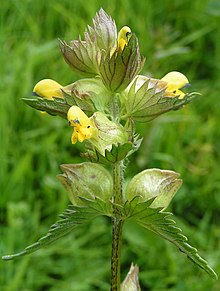Rhinantheae is a tribe with fewer than 20 genera of herbaceous plants in the family Orobanchaceae.[1]
| Rhinantheae | |
|---|---|

| |
| Rhinanthus minor | |
| Scientific classification | |
| Kingdom: | Plantae |
| Clade: | Tracheophytes |
| Clade: | Angiosperms |
| Clade: | Eudicots |
| Clade: | Asterids |
| Order: | Lamiales |
| Family: | Orobanchaceae |
| Tribe: | Rhinantheae |
| Genera[1] | |
| Synonyms[2] | |
| |
Phylogeny
editThe phylogeny of the genera of Rhinantheae has been explored using DNA markers.[3][4] Three assemblages can be distinguished in this tribe:
- Rhinanthus is the sister genus to Lathraea, and then to Rhynchocorys. These taxa are closely related to the core Rhinanteae.
- In the core Rhinantheae, Odontites sensu lato, including Bornmuellerantha and Bartsiella, is the sister genus to Bellardia, including Parentucellia and Bartsia canescens + B. mutica. These taxa are closely related to Hedbergia (including Bartsia decurva + B. longiflora) and Tozzia. In turn, these genera share phylogenetic affinities with Euphrasia, and then with Bartsia sensu stricto (Bartsia alpina).
- Melampyrum occupies an isolated, deep-branching position.
| Genus-level cladogram of the Rhinantheae. | |||||||||||||||||||||||||||||||||||||||||||||||||||
| |||||||||||||||||||||||||||||||||||||||||||||||||||
| The cladogram has been reconstructed from nuclear and plastid DNA molecular characters (ITS, rps16 intron and trnK region).[4][3] |
The median crown age of Rhinantheae was estimated to be ca. 30 Myr.[5]
Systematics
editRhinantheae is defined as the least inclusive crown clade that includes Pterygiella nigrescens, Rhinanthus cristagalli, Melampyrum pratense, and Tozzia alpina.[1] It comprises 19 genera.
References
edit- ^ a b c McNeal, J. R.; Bennett, J. R.; Wolfe, A. D.; Mathews, S. (2013). "Phylogeny and origins of holoparasitism in Orobanchaceae". American Journal of Botany. 100 (5): 971–983. doi:10.3732/ajb.1200448. ISSN 0002-9122. PMID 23608647.
- ^ Kadereit, Joachim W. (2012-12-06). Flowering Plants · Dicotyledons: Lamiales (except Acanthaceae including Avicenniaceae). Springer Science & Business Media. p. 421. ISBN 978-3-642-18617-2.
- ^ a b Těšitel, Jakub; Říha, Pavel; Svobodová, Šárka; Malinová, Tamara; Štech, Milan (2010-10-28). "Phylogeny, Life History Evolution and Biogeography of the Rhinanthoid Orobanchaceae". Folia Geobotanica. 45 (4): 347–367. doi:10.1007/s12224-010-9089-y. ISSN 1211-9520. S2CID 39873516.
- ^ a b Scheunert, Agnes; Fleischmann, Andreas; Olano-Marín, Catalina; Bräuchler, Christian; Heubl, Günther (2012-12-14). "Phylogeny of tribe Rhinantheae (Orobanchaceae) with a focus on biogeography, cytology and re-examination of generic concepts". Taxon. 61 (6): 1269–1285. doi:10.1002/tax.616008.
- ^ Uribe-Convers, Simon; Tank, David C. (2015-11-01). "Shifts in diversification rates linked to biogeographic movement into new areas: An example of a recent radiation in the Andes" (PDF). American Journal of Botany. 102 (11): 1854–1869. doi:10.3732/ajb.1500229. ISSN 0002-9122. PMID 26542843.